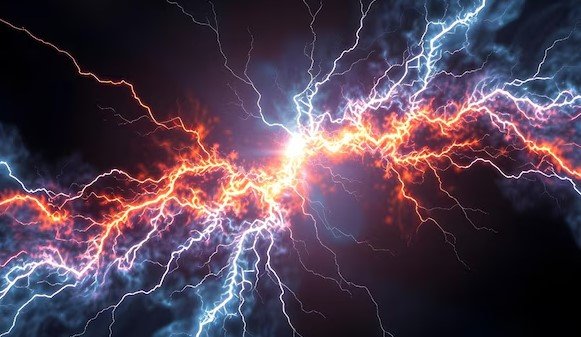Scientists in China have uncovered that ice can produce electricity when bent, a process known as flexoelectricity, and adding salt makes this effect much stronger. This breakthrough, revealed in a study published on September 15, 2025, opens doors to new sustainable energy sources from melting glaciers and could explain how lightning forms in storms.
What Researchers Discovered About Ice and Electricity
A team led by physicist Xin Wen at Xi’an Jiaotong University tested thin sheets of ice. They found that bending pure ice creates a small electric charge due to uneven deformation.
When they added salt, the charge jumped up to a thousand times higher. At 25 percent salinity, the effect peaked, far outpacing pure ice or salt alone.
This happens because salt ions move through tiny gaps in the ice structure during bending. Positive and negative charges separate, creating a streaming current.
The study shows this flexoelectric coefficient reaches up to 10 microcoulombs per meter, making it useful for real-world devices.
Experts say this matches levels in top piezoelectric materials used in sensors and gadgets today.
How Salt Amplifies the Power in Ice
Salt changes ice at a molecular level. Researchers doped ice with sodium chloride, common table salt, and measured the results.
The amplified effect comes from ions flowing along grain boundaries in the ice. This creates a strong electric field when the ice flexes.

In tests, salty ice produced an effective piezoelectric coefficient of about 4,000 picocoulombs per newton. That rivals ceramics used in modern tech.
Pure ice has a weak flexoelectric response, around 1 to 10 nanocoulombs per meter. Salt boosts it to 1 to 10 microcoulombs per meter.
This discovery builds on earlier 2025 research from the Catalan Institute of Nanoscience and Nanotechnology, which first showed ice’s flexoelectric properties.
Adding salt mimics natural conditions, like in ocean ice or glaciers with mineral impurities.
Potential for Sustainable Energy from Melting Glaciers
About 10 percent of Earth’s surface is ice, much of it salty from seas or minerals. As glaciers melt due to climate change, this process could generate clean power.
Meltwater under ice sheets already flows with ions. Capturing the streaming flexoelectricity might turn waste into energy.
In polar regions, devices could harness bending ice for remote power. This fits with global pushes for renewables, like the 2025 UN climate goals aiming for 60 percent clean energy by 2030.
Recent events, such as record glacier melt in Greenland this summer, highlight the urgency. Turning that melt into electricity could offset some climate impacts.
Experts predict prototypes for ice-based generators by 2027, focusing on cold environments where solar power struggles.
- Key benefits include low-cost materials and no emissions.
- Challenges involve scaling up for practical use in harsh conditions.
- Potential output could power small communities in icy areas.
Role in Lightning Formation and Weather Phenomena
The research links ice flexoelectricity to thunderstorms. Simulations showed colliding ice particles in clouds generate charges similar to real lightning.
This adds to known causes like friction between ice crystals. Salty ice in marine clouds might explain stronger storms over oceans.
In 2025, with extreme weather on the rise, understanding this could improve forecasts. For instance, the record lightning strikes in the Arctic this year might tie into melting salty ice.
Scientists note it compares favorably to experimental data from storm events.
| Aspect | Pure Ice | Salty Ice |
|---|---|---|
| Flexoelectric Coefficient | 1-10 nC/m | 1-10 μC/m |
| Charge Amplification | Baseline | 1,000 times higher |
| Effective Piezoelectric Coefficient | Low | ~4,000 pC/N |
| Applications | Limited | Energy devices, sensors |
Implications for Space Exploration and Alien Life
Beyond Earth, this discovery matters for icy moons like Jupiter’s Europa. Its salty ice crust covers a vast ocean, and flexing from tidal forces could generate electricity.
This energy might support chemical reactions needed for life. NASA’s Europa Clipper mission, launching in October 2025, will probe these ideas.
Similar effects could occur on Saturn’s Enceladus, another icy world with potential habitability.
Researchers suggest this brings “harnessing ice power” closer to reality, with tests planned for space analogs.
The finding ties into recent 2025 discoveries of subsurface oceans on multiple moons, sparking debates on extraterrestrial life.
Future Outlook and Challenges Ahead
While promising, challenges remain. Building durable devices for extreme cold needs more work. Costs must drop for widespread use.
Ongoing research in 2025 focuses on optimizing salt levels and materials. Collaborations between universities and energy firms are ramping up.
This could integrate with other renewables, like wind in icy regions, for hybrid systems.
Share your thoughts on this breakthrough in the comments below. If you found this article helpful, please share it with friends to spread awareness about innovative green energy solutions.
